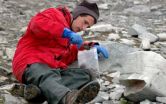(Press-News.org) Babies have a dark side under their cute exteriors, according to University of British Columbia-led study that finds infants as young as nine months embrace those who pick on individuals who are different from them.
While previous research has shown that babies generally prefer kind actors, the new study – published by the Association for Psychological Science – is the first to suggest that infants condone antisocial behavior when it is directed at individuals who are dissimilar.
"Our research shows that by nine months, babies are busy assessing their surroundings, trying to determine who is friend or foe," says Prof. Kiley Hamlin of UBC's Dept. of Psychology, lead author of the study. "One important way they make these distinctions, our study finds, is based on perceived differences and similarities."
To explore this, researchers had babies choose which food they preferred: graham crackers or green beans. The infants then watched a puppet show in which one puppet demonstrated the same food preference as the infant, while another exhibited the opposite preference.
In the experiments, other puppets harmed, helped or acted neutrally towards the puppets with different or similar food preferences. Prompted to pick their favorite puppet, infants demonstrated a strong preference for the puppets who harmed the "dissimilar" puppet and helped the "similar" one – one infant even planted a kiss on the puppet she liked.
"These findings suggest that babies either feel something like schaudenfreude – pleasure when an individual they dislike or consider threatening experiences harm," says Hamlin. "Or babies have some early understanding of social alliances, recognizing that the 'enemy of their enemy' is their friend."
Hamlin describes the behaviour as an early form of the powerful, persistent social biases that exist in most adults, who favour individuals who share their origins, languages, appearances – even birthdays and sports affiliations – over people with whom they have fewer things in common.
Backgrounder
The findings suggest that when infants aged 9-14 months make social evaluations, they assess not only what people do (e.g., act nice or mean) but also to whom they do it (e.g., a person who is liked or disliked), says Hamlin, who performed the research as a graduate student of Prof. Karen Wynn of Yale University.
While studies show that humans tend to gravitate toward people who have things in common, these preferences can have a dark side, Hamlin says: disliking people who are different may lead us to mistreat them, and excuse – or even applaud – others who mistreat people who are different than us.
This does not mean that more extreme outcomes, like xenophobia and intergroup conflict, are inevitable, Hamlin says. "Rather, this research points to the importance of socialization practices that recognize just how basic these social biases might be and confront them head-on," she concludes.
###Neha Mahajan (Temple University), Zoe Liberman (University of Chicago) and Karen Wynn (Yale University) co-authored the study, which is titled, Not Like Me = Bad: Infants Prefer Those Who Harm Dissimilar Others.
Note: Multimedia available upon request.
Between 8:30 -11:45 a.m. EDT, direct media requests to:
Anna Mikulak
Association of Psychological Science
Tel: 202-293-9300
Email: amikulak@psychologicalscience.org
Friend or foe: Babies choose sides early
2013-03-12
ELSE PRESS RELEASES FROM THIS DATE:
Babies prefer individuals who harm those that aren't like them
2013-03-12
Infants as young as nine months old prefer individuals who are nice to people like them and mean to people who aren't like them, according to a new study published in Psychological Science, a journal of the Association for Psychological Science.
In our social lives, we tend to gravitate toward people who have things in common with us, whether it's growing up in the same town, disliking the same foods, or even sharing the same birthday. And research suggests that babies evaluate people in much the same way, preferring people who like the same foods, clothes, and toys that ...
Catalysts that produce 'green' fuel
2013-03-12
The energy produced by solar panels, be it heat or electricity, has to be used right away. It is hard to store and preserve and also its transportation can be rather complicated. Creating solar cells capable of producing energy in an easily storable and transportable way, that is to say fuel, is therefore the future challenge of solar energy. For this reason the scientists at SISSA are working on a catalyst that imitates and improves what nature has been able to do for millions of years.
Plants turn solar energy into sugars, the true "green" fuel, through photosynthesis. ...
RI Hospital: Radiation can be reduced while maintaining high quality in CT colonography
2013-03-12
PROVIDENCE, R.I. – A new study by a Rhode Island Hospital researcher has found it's possible to maintain high-quality CT colonography diagnostic images while reducing the radiation dose. This is important as the use of CT colonography, or virtual colonoscopy, becomes more widely used for colorectal cancer screenings.
Through his research, Kevin J. Chang, M.D., of the department of diagnostic imaging, found that decreasing the tube voltage would not negatively impact the integrity of the CT colongraphy. His research is published in the current issue of the journal Radiology.
"Radiation ...
UF study shows spiders, not birds, may drive evolution of some butterflies
2013-03-12
GAINESVILLE, Fla. --- Butterflies are among the most vibrant insects, with colorations sometimes designed to deflect predators. New University of Florida research shows some of these defenses may be driven by enemies one-tenth their size.
Since the time of Darwin 150 years ago, researchers have believed large predators like birds mainly influenced the evolution of coloration in butterflies. In the first behavioral study to directly test the defense mechanism of hairstreak butterflies, UF lepidopterist Andrei Sourakov found that the appearance of a false head – a wing ...
Scientists identify why some fathers are left holding the baby
2013-03-12
A century old mystery as to why, for some animals, it's the father rather than the mother that takes care of their young has been cracked by scientists at the University of Sheffield and University of Bath.
Researchers from the University, in collaboration with the University of Bath and Veszprém (Hungary) found that role reversal was caused by an imbalance in the numbers of males relative to females.
The findings have been published in the journal Nature Communications.
Darwin noted in 1871 that in most animals, it is the females that spend most time looking after ...
After years of growth, fewer transplants done through 'kidney chains'
2013-03-12
An additional 1,000 patients could undergo kidney transplants in the United States annually if hospitals performed more transplants using paired kidney exchanges, new Johns Hopkins research suggests.
Also known as kidney chains, paired kidney exchanges, which allow incompatible donors to give a kidney on a loved one's behalf and ensure that loved one gets a compatible kidney from a third party — usually a stranger — in return, have become much more common since 1999 when The Johns Hopkins Hospital pioneered the practice. But the dramatic growth in the use of these exchanges ...
Prediction of seasonal flu strains improves chances of universal vaccine
2013-03-12
Researchers have determined a way to predict and protect against new strains of the flu virus, in the hope of improving immunity against the disease.
Influenza is a rapidly spreading acute respiratory disease. Worldwide, annual seasonal epidemics of the flu result in 3-5 million cases of severe illness, and up to 500 000 deaths. A newly emerged virus can spread across 74 countries in 2 months.
The study led by the University of Melbourne with Monash University and international colleagues has found how to predict and potentially stop the mutating cells of the influenza ...
Antarctic and Arctic insects use different genetic mechanisms to cope with lack of water
2013-03-12
Although they live in similarly extreme ecosystems at opposite ends of the world, Antarctic insects appear to employ entirely different methods at the genetic level to cope with extremely dry conditions than their counterparts that live north of the Arctic Circle, according to National Science Foundation- (NSF) funded researchers.
Writing in the Proceedings of the National Academy of Sciences, the researchers concluded, "Polar arthropods have developed distinct... mechanisms to cope with similar desiccating conditions."
The researchers noted that aside from the significance ...
Low-cost nano-biosensor to detect foodborne pathogen that causes listeriosis
2013-03-12
New Rochelle, NY, March 12, 2013—The foodborne bacteria Listeria monocytogenes sickens about 2,500 people in the U.S. each year and many more worldwide, killing about 25-30% of those infected. Listeriosis is caused by eating food contaminated with L. monocytogenes, and current methods for detecting the bacteria are costly and time consuming. An innovative nanotechnology-based method for developing an inexpensive biosensor to detect the pathogen in food is described in Industrial Biotechnology, a peer-reviewed journal from Mary Ann Liebert Inc., publishers (http://www.liebertpub.com). ...
Repairing the nose after skin cancer in just one step
2013-03-12
ANN ARBOR, Mich. — The skin cancer growing on Carolyn Bohlmann's nose was not a very aggressive variety. But it was deep and located right on her nostril. The tricky part was not so much removing it – MOHS surgery, the procedure Bohlmann had, is a fairly common outpatient procedure.
The tricky part would be reconstructing her nostril so that it didn't lift up or droop down. It's an important cosmetic issue, but it's also critical for breathing.
Bohlmann opted for a new reconstruction technique her surgeon, Jeffrey Moyer, M.D., was offering at the University of Michigan ...


